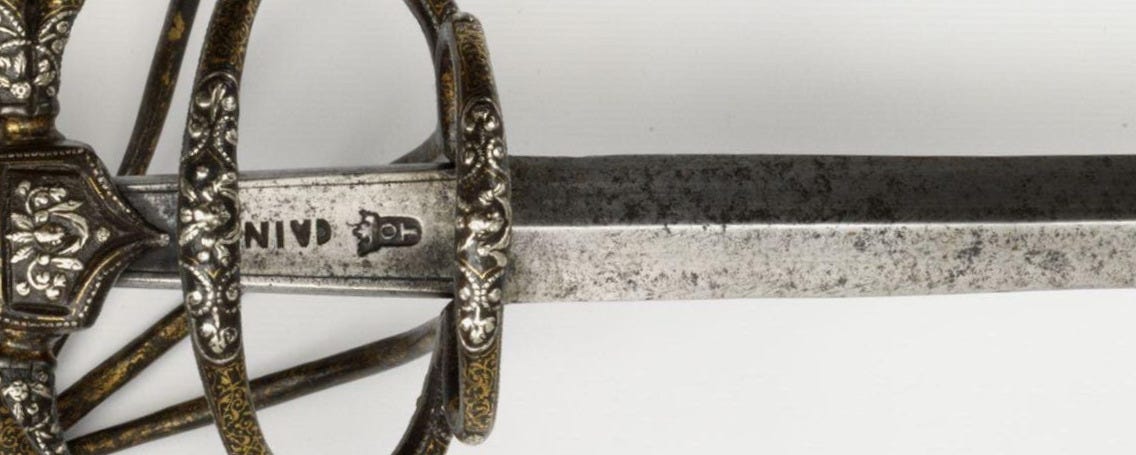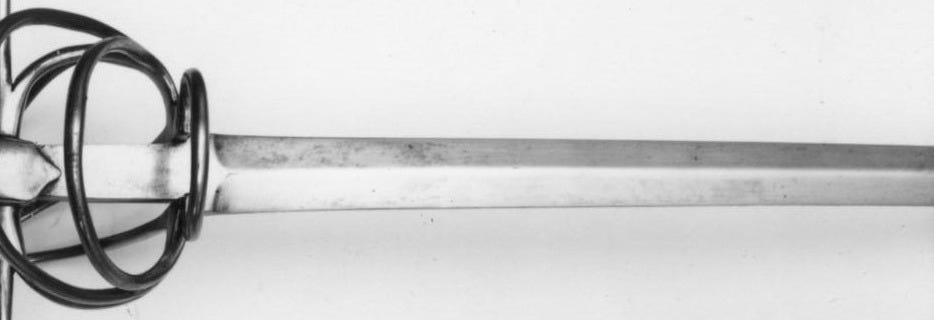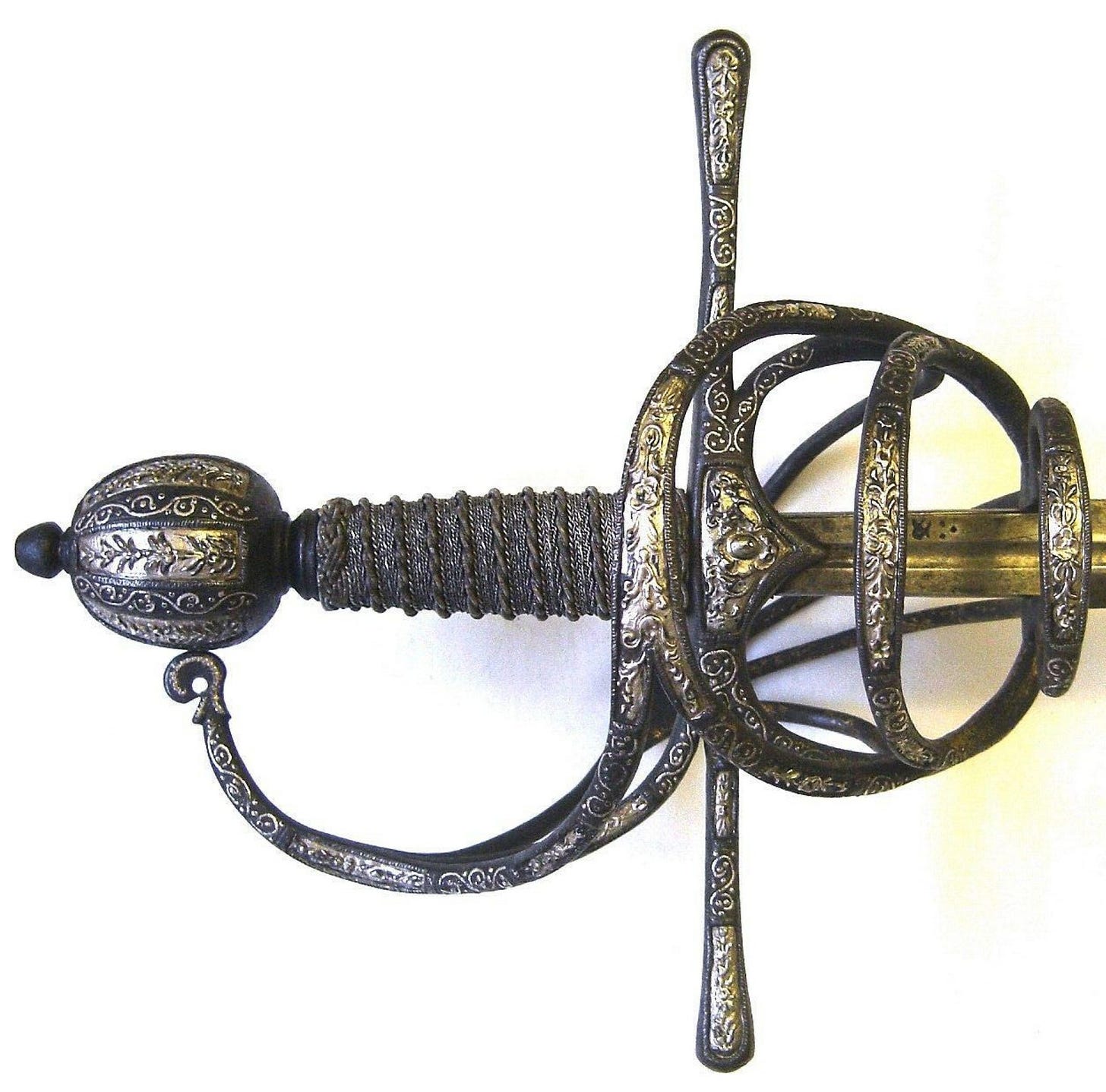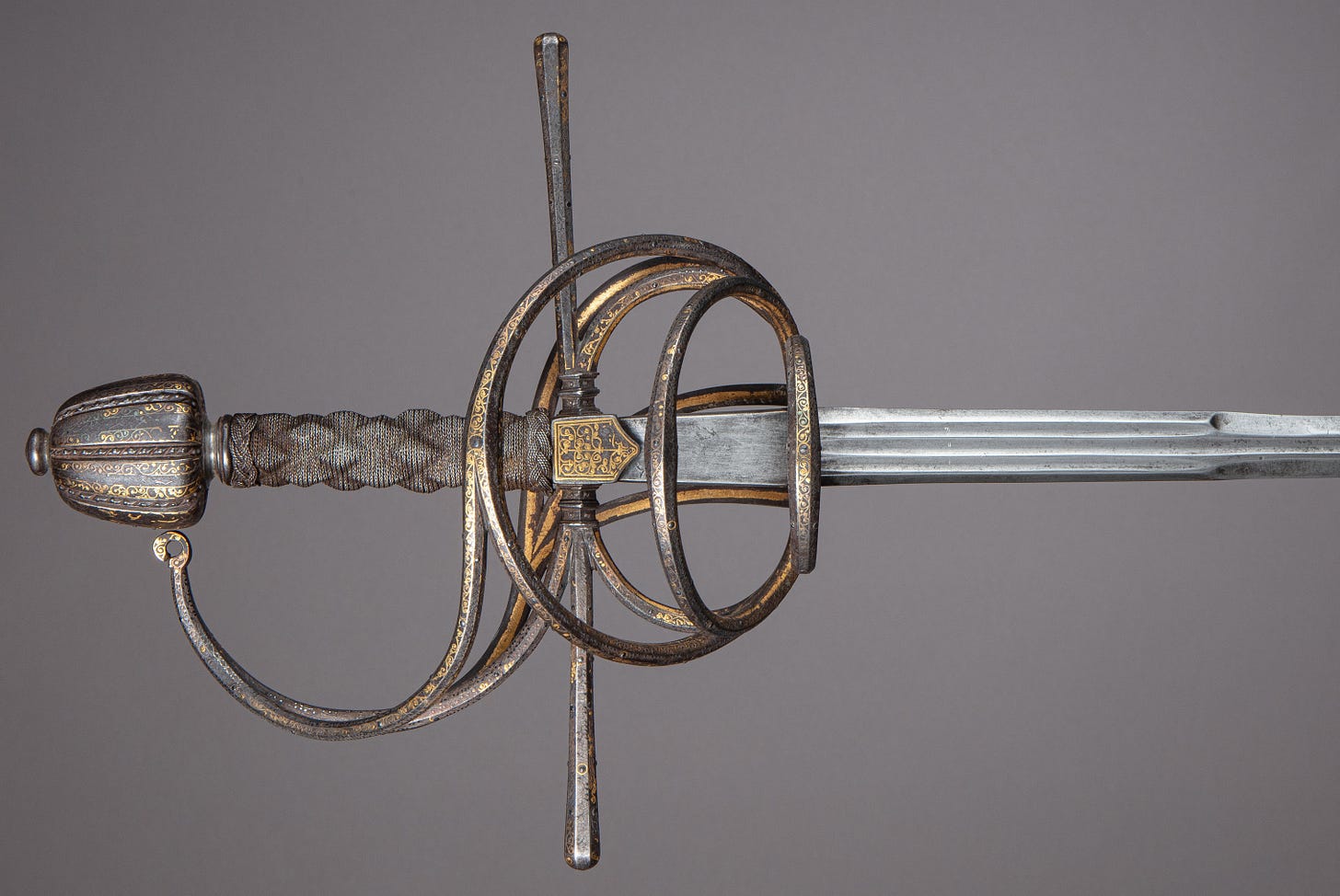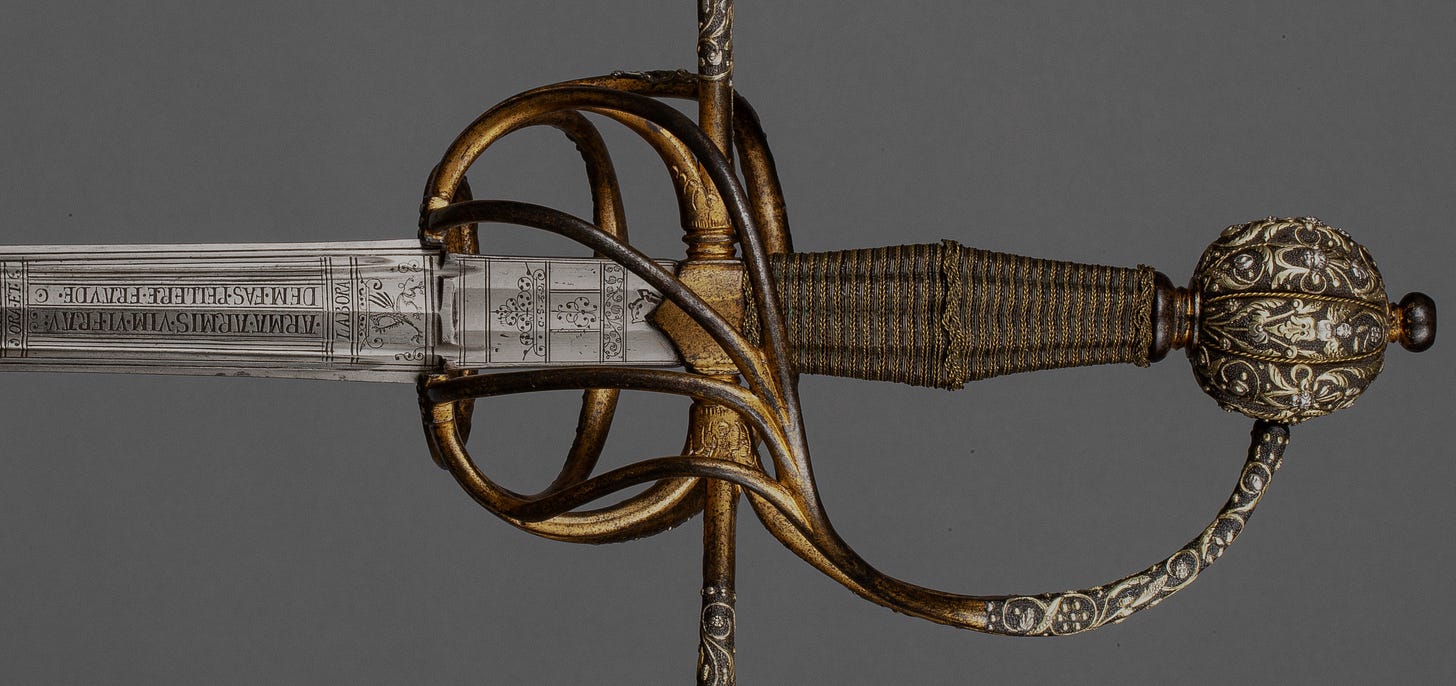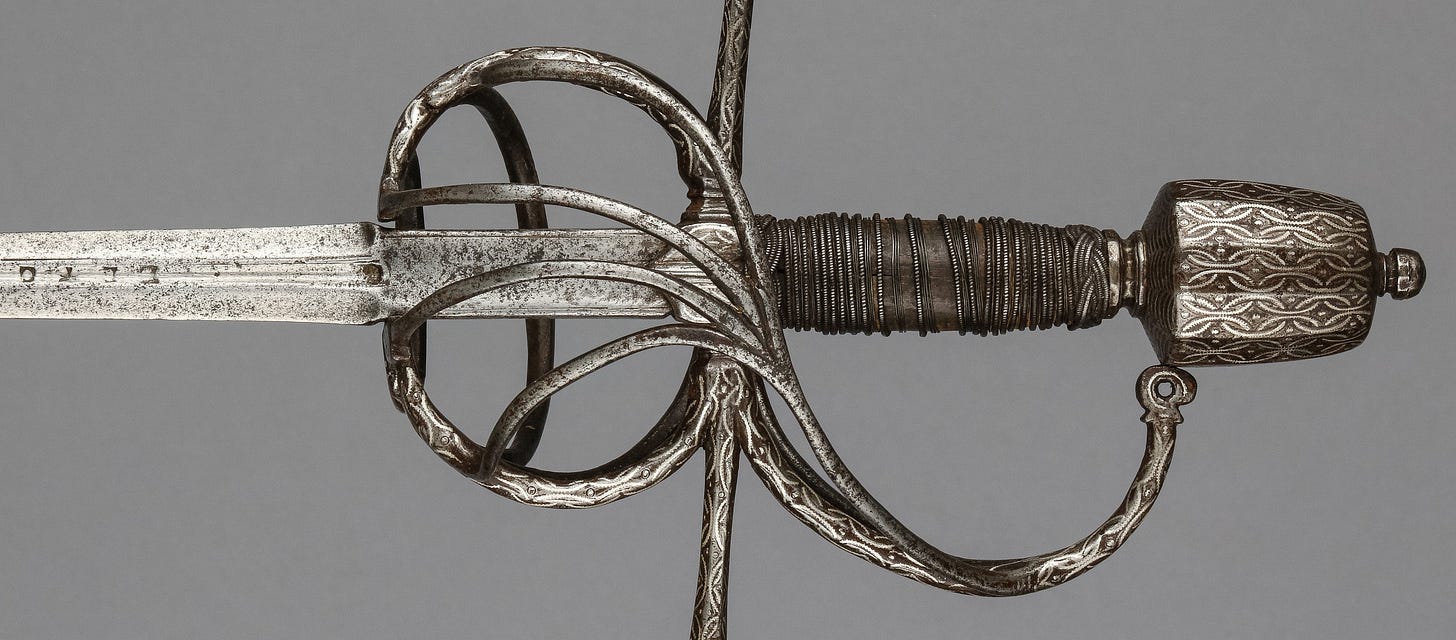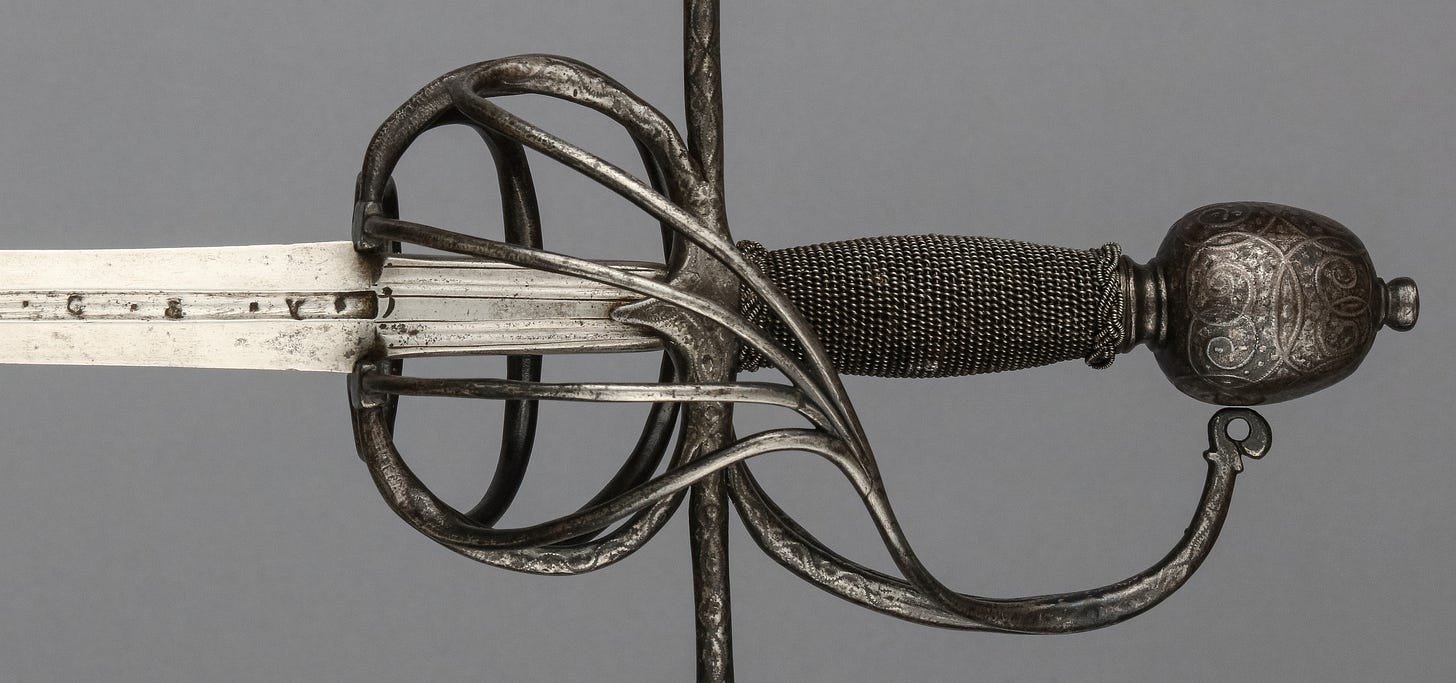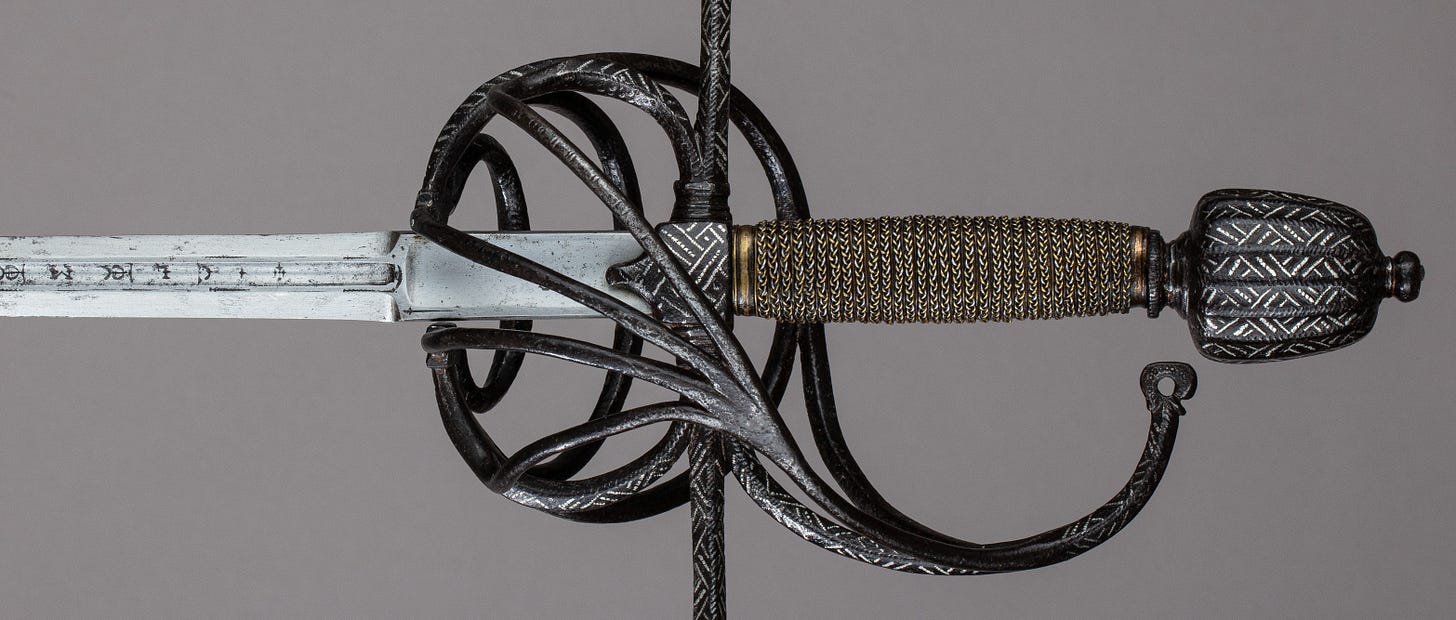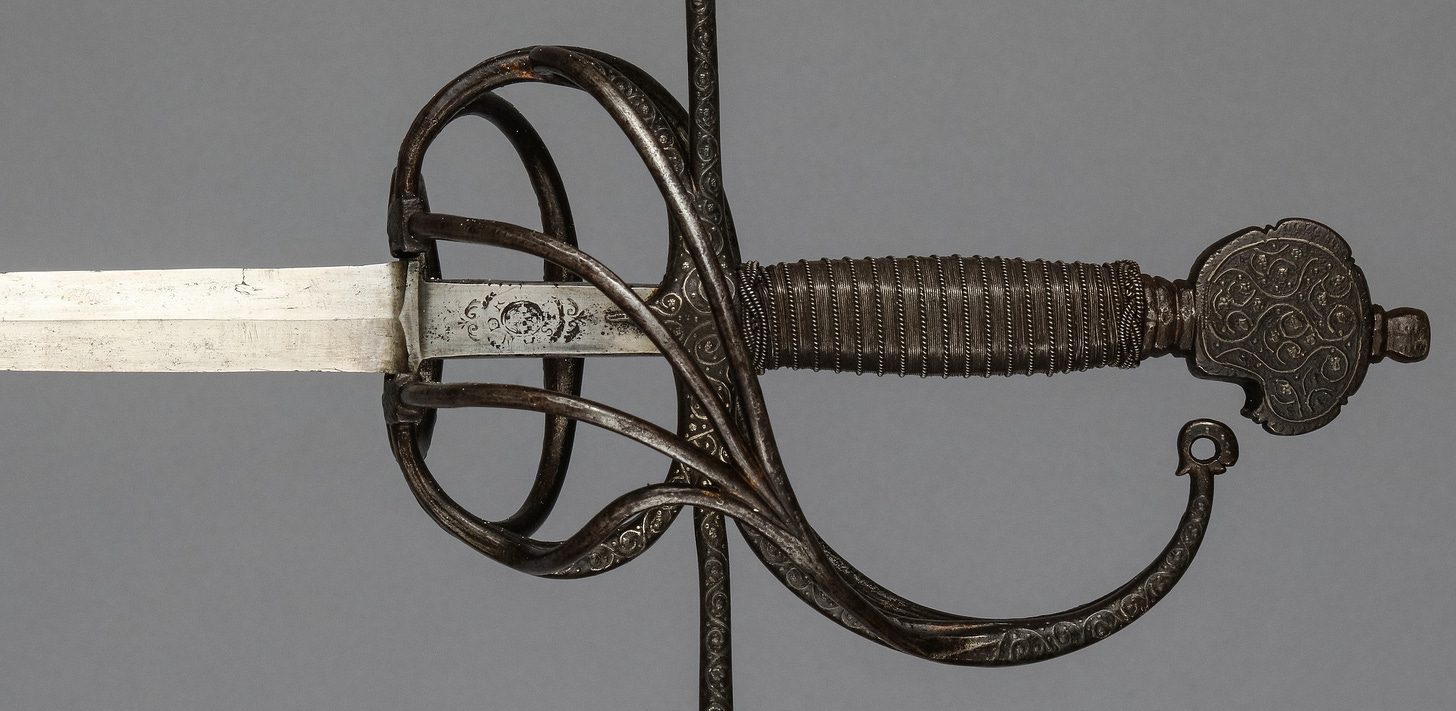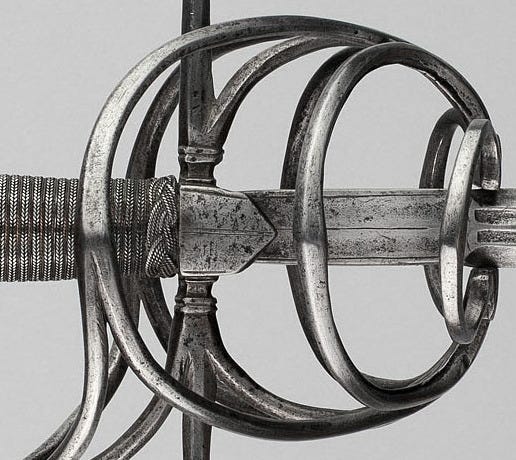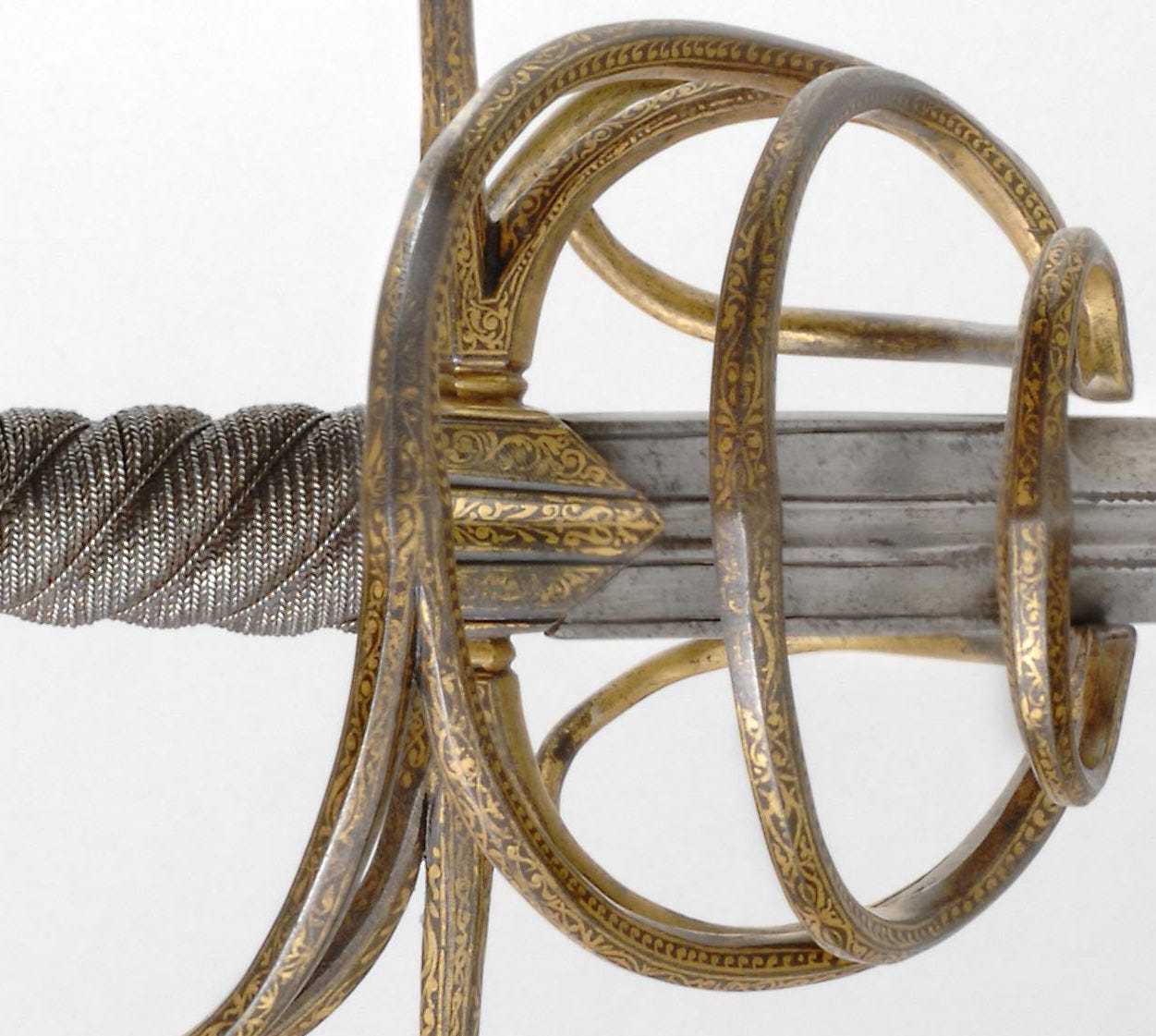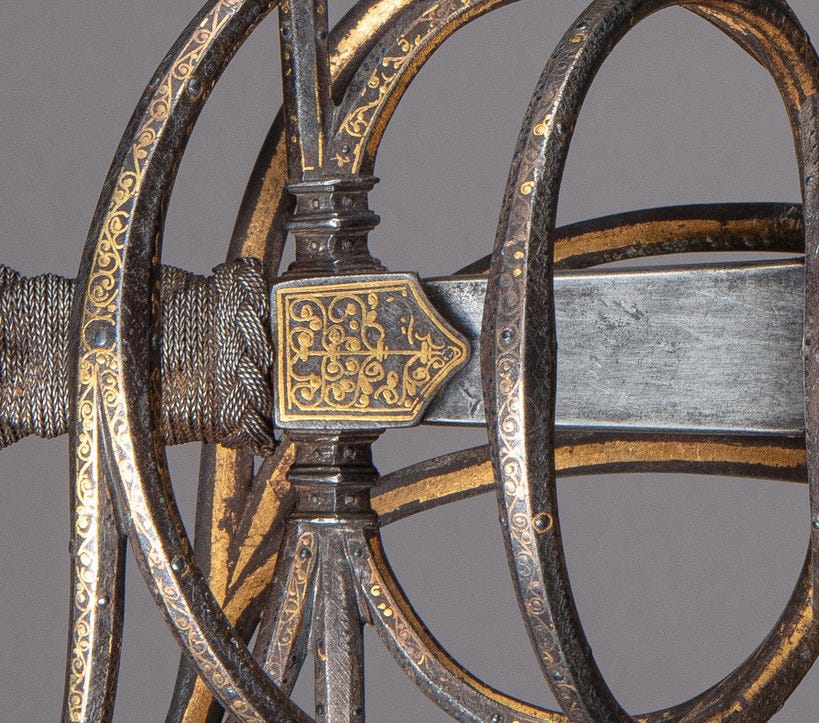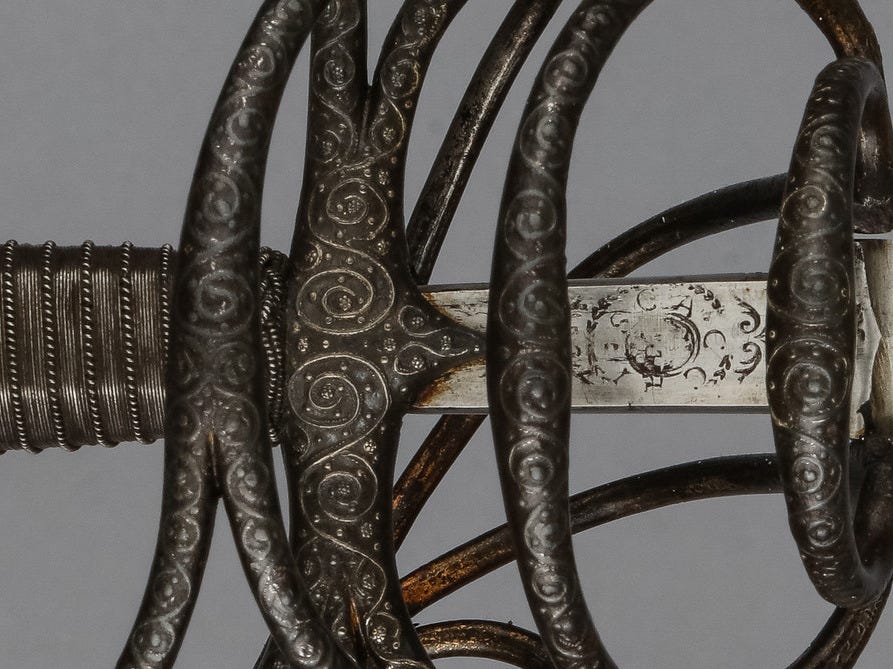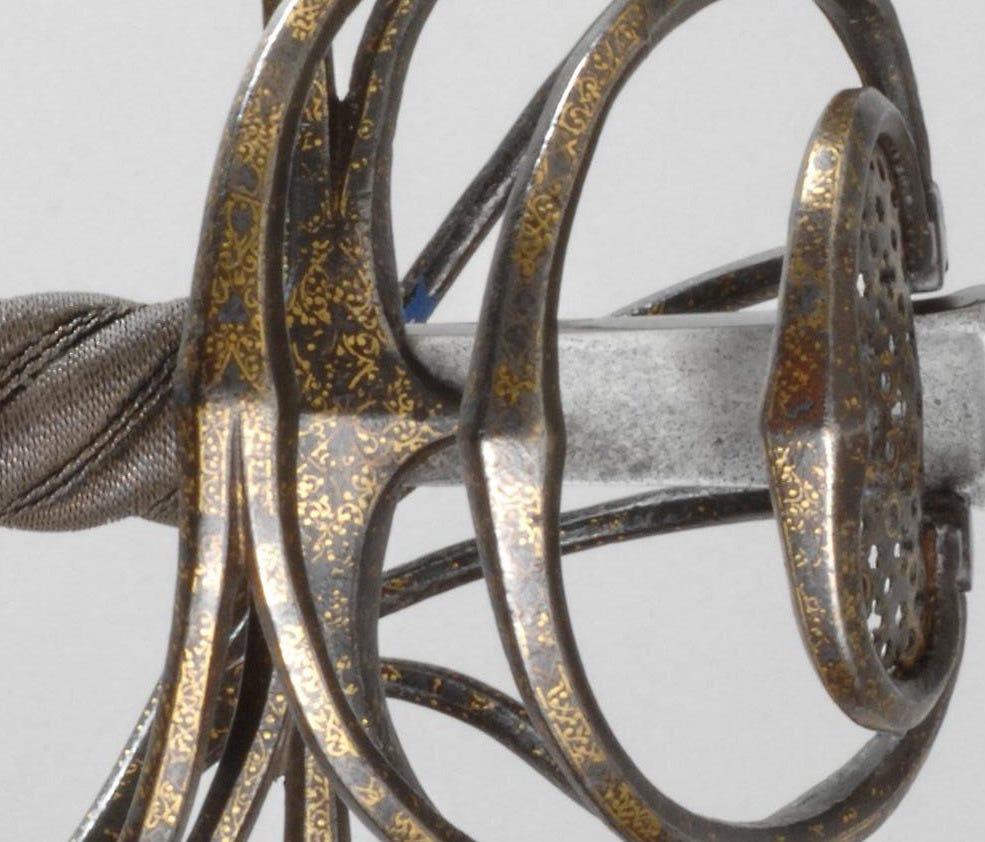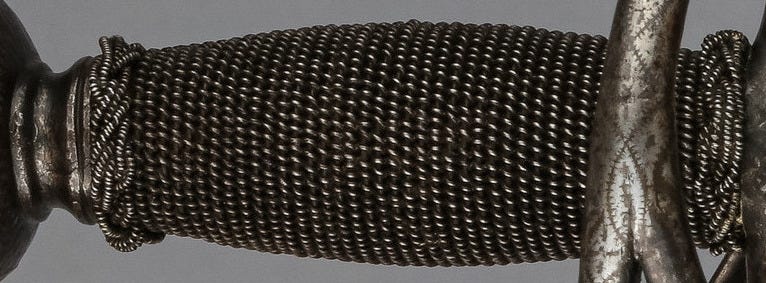Last week, I looked at as many three ring rapiers as possible from the ones listed by museums. Not only did I want to collate them and facilitate their comparison, but having them in one place allowes me to have a better idea of the biases I have regarding this hilt type. In this post, which should be seen as a follow-up, I want to create my ideal three ring rapier composite from all the best elements. I will use photos from my previous post:
What I Want in a Three Ring Rapier
For me, a rapier optimised for linear footwork is a rapier optimised for the fencing traditions of Fabris, Giganti, Capoferro, and Alfieri. I would want a blade 107-114cm long, 2.4-2.8cm wide (at its maximum), and a 1200-1300g in total weight. But how about the style of the hilt? Which master would look the best with a three ring rapier?
For Capoferro, I already talked about wanting a coil (or screw) like swept-hilt rapier; it is an aesthetic that just works considering the rapiers depicted in fencing books. For Alfieri, I would want a simple hilt, the simpler the better, while for Fabris I would want a symmetric hilt with a shell protection, maybe even a seven-ring hilt. That leaves Giganti. Being influenced by the hypothesis I made that two portraits by Tanzio Da Varallo depict Giganti (paintings one and two), I think that a three ring rapier would look right for him. Naturally, this is a superficial expression of personal preferences, but I have always liked to think about the type of rapiers old masters would want to use. Let’s look next at my favourite hilt elements, one by one.
Ideal Elements
Blade
From a general aesthetic perspective, from all the blades present on antique rapiers, there are three types of blades that I would consider:
Diamond cross-section profile: a blade with a rectangular ricasso that flares up in width as the blade transitions towards the diamond profile for the forte. Rather than a gradual widening of the ricasso, I prefer the presence of clear shoulders, which should rest on the fore-ring, not inside of it.
Fullered blade from the ricasso: a rectangular ricasso that transitions towards the rest of the blade without any shoulders. A fuller is present that starts from inside the ricasso, and the ricasso stops at the end of the hilt. Between a tapering ricasso and a straight one, I would prefer a straight one. Black lines on the ricasso can help to highlight the crisp shape, which can be accentuated by a clear transition to the sharp blade profile. This is a look for a blade that I associate with Italian sideswords, but it works on rapiers just as well.
Fullered blade outside the ricasso: a square ricasso that transitions towards the rest of the blade via abrupt shoulders, at the same place as a fuller starts. After the fuller in the forte, the narrow hexagonal blade transitions towards a diamond cross-section. The details for the ricasso matter a lot on this type of blade.
Outer Sweeps and Quillons Style
While some chiselled hilts look nice, and some decorations require a high skill that makes me wonder how they are even made, I am ultimately drawn towards the simpler sweeps. Yet even simple sweeps have their intricacies. I am only interested in straight quillons, and I limit my consideration to the following types:
Flatten bars: bars that are flattened, including D-shape cross-section rings akin to some wedding rings (or the one ring from LOTR), have an appeal.
Round bars: they form the default standard in my eyes, and I like the ones that flare up in the middle of the rings and at the end of the quillons. Stylistically, I would prefer the end of the knuckle-bow to match the end of the quillons.
Faceted bars: these are bars that flare up in the middle of the rings and at the end of the quillons, just like the round bars, but are faceted. The number of facets, usually a hexagonal arrangement, and their position can give different aesthetics.
Inner-Sweeps
Inners-sweeps can twist to close in at the level of the crossguard or at the level of the knuckle-bow. The former makes me think of sideswords, so I will only consider inner-sweeps that come out of the fore-ring and join in with the knuckle-bow. I am not considering symmetric hilts, nor the use of rings as inner guards. The only thing to look at is the number of inner-sweeps, their subtle shape and how they connect:
Three inner-sweeps: only three sweeps, without the one from below the hilt.
Four inner-sweeps: four inner-sweeps that join together.
Quilllon Block
The quillon block dictates how one can hold the rapier. It’s not just a matter of having a smooth contact for when fingering the crossguard, but also if one can pinch the blade. In essence, two types can be seen:
Flat quillon block: a flat surface, with or without decorative grooves, with a short triangular shape towards the blade. The quillons have a decorative chiselled base.
Smooth quillon block: a smooth block integrating the quillons without transitions, and small langets to help rest the thumb when fingering the guard.
Grip
The grip is very subjective, and any style will do. I tend to want to incorporate turk’s head knots at the end of the wire grip. All I know is that I do like quite a lot of them.
Pommel
A pommel should match the style of the hilt. The large majority of pommels are circular in cross-section, so we will only look at those. Smooth if round sweeps are used, faceted if faceted bars are used.
My Minimum Choice
First, I will go quickly over what I see as the minimal choice for this type of hilt, one that would keep costs down, either for the sharp reproduction or the HEMA market. I would go with the following, BL: 107cm, BW: 2.4cm, GL: 8cm, Weight: 1200g, PoB: 12cm. The 107cm blade will be seen as being long by most people, while a 2.4cm wide blade is plenty. The PoB will make the rapier feel nimble, while still having a blade presence. The weight is manageable.
Simpler diamond blade to keep costs down. Naturally, shoulders rest on the fore-ring.
Round bars that widen at the tip of the quillons and knuckle-bow. A flat quillon block it's a simple way to secure the blade while keeping the manufacturing costs low. A smooth cylindrical pommel would also be easy to make on a lathe.
I would keep this flat center grip, around 8cm long, since it’s simplee to do while having a good aesthetic. Four inner-sweeps that start from the fore-rings and follow the contour of the finger-rings. It will look better, and any cost difference compared to a three inner-sweeps solution should be negligible. The hilt should be blackend.
This is in my opinion the simplest three ring rapier that can be made, one that would appeal to a large segment of the public, and one that could be manufactured as a sharp or a HEMA trainer with minimal costs. To this day, I don't understand why mass manufacturers don’t simply offer something like I highlight here.
My Ideal Choice
BL: 110cm, BW: 2.6cm, GL: 8cm, Weight: 1250g, PoB: 13cm.
Now, for my ideal, the stats expressed above are the choices I would make to ensure a longer and a bit wider blade, with a strong presence. The weight is more a reality than a goal, with the PoB being smaller than 14cm to make sure I still have a nimble blade. The blade is long enough without impeding me in the slightest, according to the old masters’ recommendations, while the width is chosen for aesthetic appeal. The truth is that the profile of the blade can narrow down abruptly and the width of the base will not translate into more cutting potential at the tip.
For the blade, I want a rectangular ricasso, about 2cm wide. I want the blade to widen to 2.6cm and have shoulders rest on the fore-ring. The narrow hexagonal blade at the forte will have a fuller, and it will transition towards a diamond cross-section for the debole of the blade and tip. Thin black lines will highlight the blade’s features.
For the style of the sweeps, I want hexagonal faceted bars, that flare up in the middle of the rings and at the end of the quillons. The facets seen from the profile look flat. The separation of the sweep from the aft-ring, as it connects to the knuckle-bow, will be after the thickest part of the ring. The fore-ring will have a closed port, via a perforated plate. The entire hilt should be blackened.
I will ask for the end of the knuckle-bow to have the same style as the end of the quillons and I would like for the four inner-sweeps to start from the fore-ring, follow the contour of the finger-rings and join together before joining the knuckle-bow.
For the quillon block, a smooth choice, with a bit of faceted work to integrate it into the aesthetic of the hilt.
For the pommel, I want an ovoid pommel with rounded groves. This will leave the resulting facets of the pommel matching the faceted design of the outer-sweeps and quillons, while still having a rounder pommel that feels more comfortable at the base of the hand.
A grip that fills in the hand in the middle is prefered, and wire pattern displayed below is the most appealing to me for this piece.
While small tweaks here and there can be made, I consider this to be a great choice for a three ring rapier, one that is inline with historical elements and the spirit invoked by such a sword.
A Last Thought
I think these types of mental exercises help discover and solidify personal preferences. While one can design a rapier using fantasy elements just as easily, I think that looking at antiques can help preserve the intent behind these old pieces. This is also why I start by thinking of an old master and the use of a piece before anything else.





